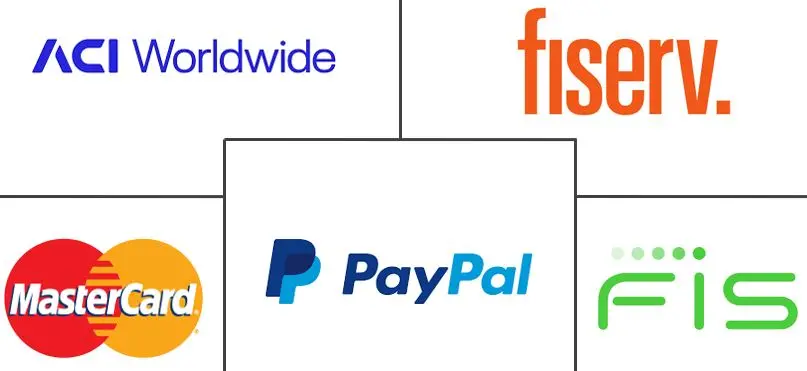Market Size of Japan Real Time Payment Industry

| Study Period | 2019 - 2029 |
| Base Year For Estimation | 2023 |
| Market Size (2024) | USD 2.04 Billion |
| Market Size (2029) | USD 8.44 Billion |
| CAGR (2024 - 2029) | 32.76 % |
| Market Concentration | Low |
Major Players
*Disclaimer: Major Players sorted in no particular order |
Japan Real-Time Payment Market Analysis
The Japan Real Time Payment Market size is estimated at USD 2.04 billion in 2024, and is expected to reach USD 8.44 billion by 2029, growing at a CAGR of 32.76% during the forecast period (2024-2029).
Real-time payment systems were proliferating due to increased consumer adoption for speed and convenience and the continued shift away from cash with payment solutions enabled by innovation and regulation.
- The growing adoption of smart devices and booming online retail commerce drive the rapid adoption of real-time payments in the country. Also, the rising tide of real-time payments reflects growing consumer demand for real-time transactions, driven due to the ubiquity of smartphones and other connected devices, which have catalyzed consumer expectations for immediacy.
- Several initiatives by the Japanese government, including financial incentives, standardization, and infrastructure development, are also adding growth to the real-time payment market. For instance, the government is planning to introduce a platform for wages through a digital platform which could further contribute to the adoption among consumers. Also, the government has set a target of growing cashless payments to around 40% of all transactions by 2025, up from approximately 20%.
- However, the larger dependence of the population on cash (traditional method), cost of implementation, and low consumer demand as they prefer traditional payment systems are the factors challenging the growth of the real-time payment market in Japan.
- Several market players are expanding their offering of real-time payment systems in the country. In December 2022, Adyen launched its unified commerce solution in Japan to provide a payment platform that connects different online and offline sales channels. Such introductions from the vendors are expected to fuel the market growth during the forecast period.
- The outbreak of the COVID-19 pandemic greatly impacted the real-time payment market. With the country's focus on digital transformation and its advanced technology infrastructure, real-time payment solutions had widespread adoption. Additionally, the pandemic accelerated the trend toward cashless payment methods, leading to greater use of mobile payment solutions and e-wallets. This also helped spur innovation in the real-time payment industry as companies compete to offer more convenient and secure solutions.
Japan Real-Time Payment Industry Segmentation
Real-time payments are instant or immediate payments and are defined by the Euro Retail Payments Board (ERPB) as electronic retail payment solutions that are available 24/7/365. Immediate payments enable businesses and consumers to make and receive payments in real-time, providing convenience, speed, and faster availability of funds.
Japan's Real-Time Payment Market is segmented by Type (P2P, P2B). The market sizes and forecasts are provided in terms of value (USD million) for all the above segments.
| By Type of Payment | |
| P2P | |
| P2B |
Japan Real Time Payment Market Size Summary
The Japan real-time payment market is experiencing significant growth, driven by increased consumer adoption of digital payment solutions that offer speed and convenience. The shift away from cash transactions is supported by innovations in payment technology and regulatory measures. The proliferation of smart devices and the expansion of online retail commerce are key factors propelling the adoption of real-time payments. The Japanese government's initiatives, such as financial incentives and infrastructure development, are further enhancing market growth. These efforts include plans to introduce digital wage platforms and increase the share of cashless transactions, aiming to boost tourism and stimulate financial sector innovation.
Despite the promising growth trajectory, challenges such as the population's reliance on cash, implementation costs, and consumer preference for traditional payment methods pose obstacles to market expansion. The COVID-19 pandemic has accelerated the shift towards cashless payments, with mobile payment solutions and e-wallets gaining traction. Digital payment methods, including QR code payments and contactless card payments, are becoming increasingly popular due to their convenience and security. The market is characterized by fragmentation, with numerous players expanding their offerings through strategic partnerships and technological advancements. These developments are expected to drive further growth in the real-time payment sector in Japan.
Japan Real Time Payment Market Size - Table of Contents
-
1. MARKET INSIGHTS
-
1.1 Market Overview
-
1.2 Industry Attractiveness- Porter's Five Forces Analysis
-
1.2.1 Bargaining Power of Suppliers
-
1.2.2 Bargaining Power of Buyers/Consumers
-
1.2.3 Threat of New Entrants
-
1.2.4 Threat of Substitute Products
-
1.2.5 Intensity of Competitive Rivalry
-
-
1.3 Evolution of the Payments Landscape in the Country
-
1.4 Key Market Trends Pertaining to the Growth of Cashless Transaction in the Region
-
1.5 Assessment of Impact of COVID-19 on the Market
-
-
2. Market Segmentation
-
2.1 By Type of Payment
-
2.1.1 P2P
-
2.1.2 P2B
-
-
Japan Real Time Payment Market Size FAQs
How big is the Japan Real Time Payment Market?
The Japan Real Time Payment Market size is expected to reach USD 2.04 billion in 2024 and grow at a CAGR of 32.76% to reach USD 8.44 billion by 2029.
What is the current Japan Real Time Payment Market size?
In 2024, the Japan Real Time Payment Market size is expected to reach USD 2.04 billion.

